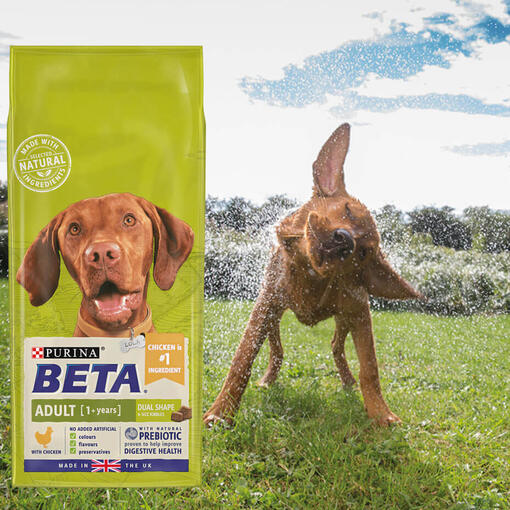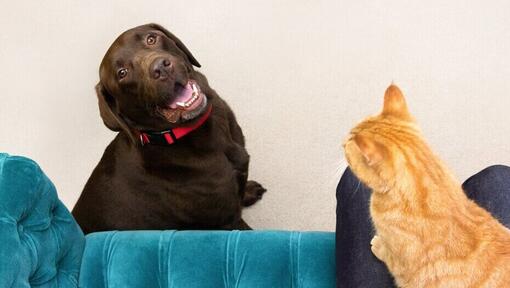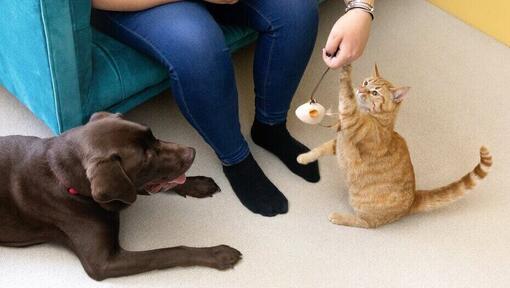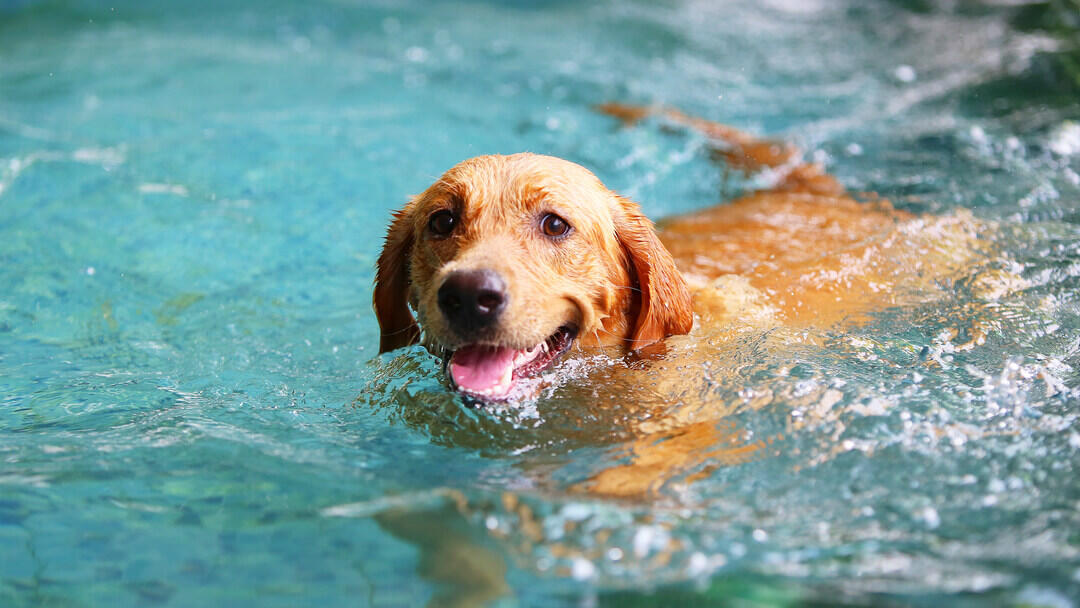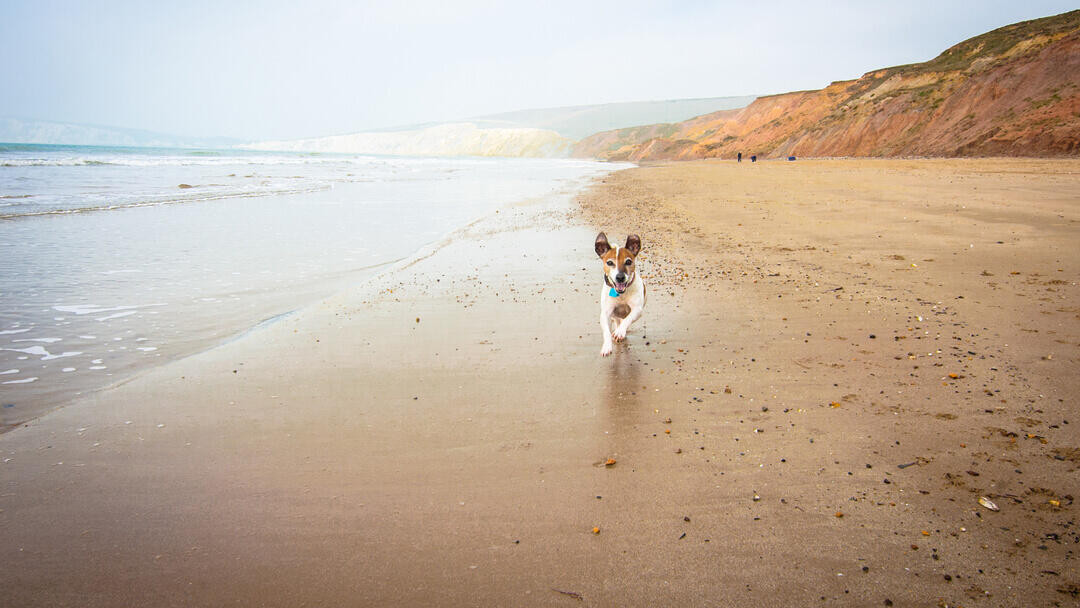


Most dogs and cats can live together in perfect harmony, but sometimes there can be a little tension. Dogs are social animals who love company, while cats are often loners who prefer independence. And their play styles are very different. Dogs often play with other canines by chasing them, which cats dislike and may perceive as a threat.
Stopping this chasing behaviour from the very start is very important, as it can lead to a very stressed and unhappy cat if left unchecked, even if your dog is well-meaning. Moreover, your cat will interpret it as predatory behaviour and will want to hide to feel safe – and may well even consider leaving home.
But fear not – this behaviour can usually be controlled. In this article, we’ll explore why dogs chase cats, how to stop dogs from chasing your cats, and what to do if they do not stop.
Why do dogs chase cats?
When a dog chases a cat, it is usually because they are following their instincts – particularly if your dog is a breed originally used for chasing or herding. Other times, when a dog chases cats, they might just want to play like they would with another dog, and so when the cat runs, the temptation to chase them is too much – because it is fun!
Dogs chase cats because they have a strong chase instinct, and that movement can trigger this instinct. However, there are instances of dogs living with cats for years without chasing them before suddenly developing this instinct – especially if a new cat is introduced to the household that isn’t dog-savvy.
There are however some dogs who chase cats with predatory intent, and this must be both managed and prevented.
If you have cats – or plan to have cats – this is something you should factor into your choice of puppy or dog breed. Some are happy to live with other animals whereas other find it far more challenging. Even better is if you can find a breeder who rears their puppies with cats, so they are used to them – or else find a rescue dog who has lived with cats in the past.
It is important to stop dogs chasing cats as soon as you see this behaviour in your own canine companion. Dogs should see cats as their companions, or else ignore them, and not look on them as toys.
How to stop dogs chasing cats: a step-by-step-guide
Prevention is by far the best way to stop your dog chasing cats. If your dog never gets the chance to find out how much fun it is, and your cat always feels safe enough that they don’t have to run, it never becomes a problem.
Look at our article on how to introduce dogs to cats – and make sure you do this from the very start of your dog and cat’s loves together. This should be done with every new canine or feline arrival.
If you’re wondering how to stop dogs from chasing cats, we have come up with two different methods below for you to try. It is much easier to train your dog if they are a puppy, as you can easily socialise your dog into recognising that chasing cats is not acceptable behaviour.
Method 1 - Prevent chasing – and build feline confidence
It is important that your cat feels confident – and knows that they have an escape route. If the cat doesn’t run, the dog can’t chase them!
Put stair gates up in the doorways of your main room that your cat can get through, but your dog can’t.
Have some tasty treats that you know your dog loves.
If your dog or puppy is crate trained, start with them in a crate. If not, a puppy pen will work just as well (just make sure your dog can’t escape from it).
Then let the cat come into the room when they are happy to do so (don’t force them - it must be their idea when they feel confident enough). Your dog or puppy will probably be intrigued by the cat and will watch them, try to get to them or just be totally fixated on them. Once the initial excitement of having a cat in the room wears off, try saying your dog’s name and if they look at you, throw them a treat.
Any time after that when they look at you, give a treat. Teach them that you are much more interesting than the cat is…! They can’t chase the cat, but if they look at you instead, then they get something yummy. After a few repetitions, all but the most cat-obsessed will begin look at you as soon as you say their name.
The aim is to do this each time your dog looks at the cat. Each time they look at the cat, call them and when they look at you, reward them with a treat. If they come towards you, give them a jackpot of treats. This will emphasise that they should not bother the cat. They will begin to associate leaving the cat alone with being rewarded.
Using a harness and a long training lead, release your puppy (if it is safe to do so) and try again. If your dog persists in approaching the cat, call them to you and reward them when they look at you.
This is something that takes patience and time – and while you are teaching this, you do have to make sure that your dog never gets the chance to chase the cat – so it does mean being constantly vigilant.
Sometimes, though dogs can be more persistent in their cat obsession or has already learning that cats are fun to chase. In such cases, you may need a more detailed plan to try and stop your dog from chasing the cat.
Method 2 - Call the dog to you
Always have treats on hand.
If your dog starts to show an interest in the cat, instantly call their attention to you. Stop what you are doing to make sure they look at you – and encourage them to come to you by dropping the treat on the floor close to your feet. This will encourage them to turn their focus away from the cat and come to you when they are called. This is important because you want to stop the chase before it begins.
Each time your dog notices your cat, repeat the above action.
If your dog begins chasing your cat, it is important to stop the chase. Using a lightweight houseline attached to your dog’s collar is the best way to do this – as you can catch hold of it, or even stand on it if necessary. As soon as the dog stops, give them a treat (even if it wasn’t their idea!).
Always make sure the cat has an escape route via stair gates so they can get themselves out of trouble if they need to. Never prevent the cat from leaving.
If this method still does not stop your dog from chasing the cat, you may need to employ a different method.
Method 3 – Use a training lead
If your dog keeps chasing the cat, try keeping your dog on an adjustable-length training lead in the house and have that attached to you. Keep treats on hand.
Whenever your dog looks at the cat, call their attention to you. If they give you their attention, or better still come to you, give them a treat. Repeat this each time the cat is there and when your pup looks at your cat. The lead will make sure your cat can roam freely without being chased and it will give you better control of your dog and make sure that they can’t even start to chase.
In time, your dog should start looking automatically at you when the cat is in the vicinity. Here, you can lengthen the lead and let your dog roam a bit more until you are confident that you can stop them from chasing.
Once your dog shows little to no interest in chasing your cat both when close to you and when on a longer lead, you can allow them to roam freely with the cat although always under your supervision.
Remember, lots of treats for good behaviour will help get your point across and stop your dog from chasing the cat.
Make sure your cat gets plenty of attention too. This might mean frequent time when your dog is in a play pen and the cat can roam free, or it might be preventing the dog from going in certain rooms that your cat likes hanging out in.
IMPORTANT NOTE: If you have concerns that your dog might injure your cat or if you think the chasing is predatory rather than just play or fun, contact a behaviourist who can look at your dog’s behaviour and give you more help. This can be more common in terriers breeds and sighthounds – but any dog can be a danger to cats.
Other ways to stop dogs chasing cats
Some dogs will chase the cat because they are bored or frustrated – and the cat is the most exciting thing in the house. Make sure your dog is getting enough exercise, and also enough games and play. This is especially true of breeds that were created to chase or herd.
Also brush up on their training – especially recall with distractions.
Will my dog ever stop chasing my cat?
In time, with consistency and practise – and as the dog gets used to the cat - they will usually learn to leave the cat alone and stop chasing after them. Many even become friends. If you have any concerns, however, consult a behaviourist.
Top tips for training your dog to stop chasing your cat
When training your dog to stop chasing cats, there are a few things that owners need to make sure they are avoiding. Using physical punishment or negative reinforcement will slow the process and can cause your dog to become scared of you. Here are a few tips to training.
1. Never use physical punishment
Physical punishment should never be used at any point during a dog’s lifetime. This can cause them to become fearful of you or of being around people in certain situations. Due to this behaviour, your dog may become aggressive when punished.
2. Always use positive reinforcement
Positive reinforcement uses rewards such as treats, praise or toys for certain behaviours. Reward-based reinforcement will make your dog more likely to repeat the desired behaviour as they enjoy the result.
3. Be patient and consistent
Training your dog to stop chasing cats won’t happen in one training session – it can even take weeks! This is why all owners need to understand and appreciate the value of patience and consistency – even when you think you aren’t getting anywhere. In some training sessions, you may find that your dog has lost all concentration, this is when an owner's patience can wear thin. But stay calm, be consistent, and come back to it at a better time.
4. You are training 24/7
Remember that training isn’t something you only do for a few minutes a day or when you remember. Your dog is learning from you every minute of every day – and when it comes to life skills such as not chasing the cat, you have to be alert and ready to reward good behaviour – and prevent any slip-ups – every moment of the day.
5. Safety first
It is important that you keep both your cat – and your dog safe. The cat must always have a choice of escape routes. This means they can get themselves out of trouble if they feel stressed or scared. It also means that your dog is less likely to be able to corner your cat – as if they feel they have to defend themselves, a cat can cause serious injury to a puppy with their claws.
If you have any safety concerns, talk to a behaviourist who can help.

More articles by Beta



